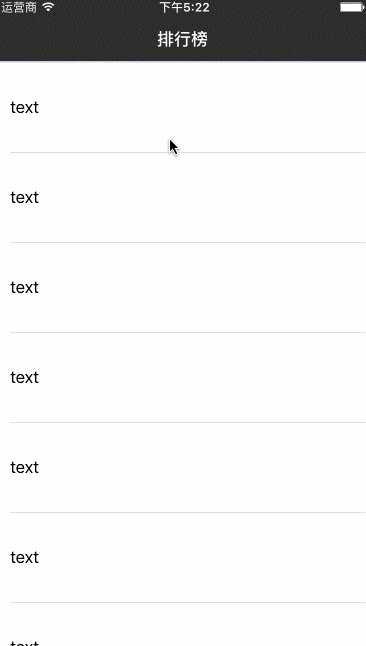标签:
说点题外话:
我刚来现在这家公司的时候,老板让我下载一个脉脉,上去找找自己的同行,多认识些同行。其实初衷的好的,但最近这两天我把它卸载了,不为别的,负能量太多!iOS这行自从2016就没景气过,在这行混,这些自己也肯定都知道。但就是受不鸟铺天盖地的多久没找到工作,满大街都是iOS程序猿这些话题。看了也给我带不来任何的作用,你唯一能做的就是安安静静的做好自己该做的。自己入iOS这行也一年半过了,除去培训的那个几个月,真正摸爬滚打也一年多了,有时候想想,其实也没觉得有多差,以后怎样不知道,但至少现在,你有份工作,有口饭吃,还有时间给你去学,有什么不知足的呢?在我自己浅薄的意识里,编程思想都是相同的,喜欢iOS你也可能也会喜欢安卓,Java,JS,PHP等等等。。活到老,学到老,那颗不停的去学的心就是自己最大的依靠。
回归正题:
以前有了解过Runtime,不记得是几个月前的事情了,最近又遇到这个问题,还是总结一下吧,总结的不好的地方,见谅了。。
Runtime俗称“运行时”,项目都有分一个编译和运行两个状态,这个应该了解。是一套底层的C语言的API。OC是一门动态的语言,有些东西不会放在我们编译的时候去处理,会等到运行时去处理。下面说的这些,建议大家随表这个项目,导入下面头文件点进去我们一起慢慢探讨!
#import <objc/runtime.h>
看看他最上面:
/// An opaque type that represents a method in a class definition. typedef struct objc_method *Method; // 方法 /// An opaque type that represents an instance variable. typedef struct objc_ivar *Ivar; // 变量 /// An opaque type that represents a category. typedef struct objc_category *Category; // 类别也叫分类 /// An opaque type that represents an Objective-C declared property. typedef struct objc_property *objc_property_t; // 属性
定义在上面代码的注释里我们说了,再往下看你就看到的是类的表示:
struct objc_class {
Class isa OBJC_ISA_AVAILABILITY;
#if !__OBJC2__
Class super_class OBJC2_UNAVAILABLE;
const char *name OBJC2_UNAVAILABLE;
long version OBJC2_UNAVAILABLE;
long info OBJC2_UNAVAILABLE;
long instance_size OBJC2_UNAVAILABLE;
struct objc_ivar_list *ivars OBJC2_UNAVAILABLE;
struct objc_method_list **methodLists OBJC2_UNAVAILABLE;
struct objc_cache *cache OBJC2_UNAVAILABLE;
struct objc_protocol_list *protocols OBJC2_UNAVAILABLE;
#endif
} OBJC2_UNAVAILABLE;
/* Use `Class` instead of `struct objc_class *` */
Class super_class指向父类。
const char *name 类的名字long version 类的版本信息,初始化默认为0,下面有函数class_setVersion和class_getVersion可以对它进行进行修改和读
long info 标识。
long instance_size 类的实例变量的大小,包括继承的父类的。
struct objc_ivar_list *ivars 成员变量的地址。
struct objc_method_list **methodLists
struct objc_cache *cache 指向最近使用的方法的指针struct objc_protocol_list *protocols 遵守的协议。
下面就是一系列的方法了,这里总结常见的,在下面的代码注释里面会说的比较详细点:
#import "ViewController.h"
#import <objc/runtime.h>
/**
* 定义一个测试的协议
*/
@protocol protocolTestDelegate <NSObject>
@optional -(void)protocolTestDelegate;
@end
@interface ViewController ()
/**
* 定义三个测试的属性
*/
@property (nonatomic,strong) NSString * testString1;
@property (nonatomic,strong) NSString * testString2;
@property (nonatomic,strong) NSString * testString3;
@end
@implementation ViewController
-(void)viewDidLoad {
[super viewDidLoad];
/**
* 定义三个测试的成员变量
*/
NSString * Stringone;
NSString * Stringtwo;
NSString * Stringthree;
unsigned int count;
// OBJC_EXPORT objc_property_t *class_copyPropertyList(Class cls, unsigned int *outCount)
// 下面是官方的注释,大概翻译;
/**
描述一个类的属性列表
* Describes the properties declared by a class.
*
* @param cls The class you want to inspect.
参数 outCount这个参数是返回了你这个属性列表数组的长度
* @param outCount On return, contains the length of the returned array.
* If \e outCount is \c NULL, the length is not returned.
*
这个方法返回的是一个属性的列表数组
* @return An array of pointers of type \c objc_property_t describing the properties
* declared by the class. Any properties declared by superclasses are not included.
返回的数组包含的 outCount 指针用NULL结尾的,必须释放这个array用free()
* The array contains \c *outCount pointers followed by a \c NULL terminator. You must free the array with \c free().
*
* If \e cls declares no properties, or \e cls is \c Nil, returns \c NULL and \c *outCount is \c 0.
*/
// 这里传的是 &count ,是 count 的地址,outCount是返回的数组的长度的指针,传值就传变量的地址,系统就把长度返回给了这个变量
// 属性
objc_property_t * propertyList = class_copyPropertyList([self class],&count);
for (unsigned int i = 0; i<count; i++) {
// objc_property_t property
// (nonnull const char *)
const char * property = property_getName(propertyList[i]);
NSLog(@"property %@",[NSString stringWithUTF8String:property]);
}
/**
* 打印
2016-08-29 11:37:03.302 RunTimeTest[10078:132260] property testString1
2016-08-29 11:37:03.303 RunTimeTest[10078:132260] property testString2
2016-08-29 11:37:03.303 RunTimeTest[10078:132260] property testString3
*/
// 方法
Method * methontList = class_copyMethodList([self class], &count);
for (unsigned int i = 0 ; i<count; i++) {
Method methond = methontList[i];
NSLog(@"methond %@",NSStringFromSelector(method_getName(methond)));
}
/**
*
2016-08-29 14:01:30.458 RunTimeTest[16581:201546] methond ClassTestone
2016-08-29 14:01:30.458 RunTimeTest[16581:201546] methond ClassTesttwo
2016-08-29 14:01:30.459 RunTimeTest[16581:201546] methond ClassTesthree
2016-08-29 14:01:30.459 RunTimeTest[16581:201546] methond testString1 // testString1 get方法
2016-08-29 14:01:30.459 RunTimeTest[16581:201546] methond setTestString1:
2016-08-29 14:01:30.459 RunTimeTest[16581:201546] methond testString2
2016-08-29 14:01:30.459 RunTimeTest[16581:201546] methond setTestString2:
2016-08-29 14:01:30.459 RunTimeTest[16581:201546] methond testString3
2016-08-29 14:01:30.459 RunTimeTest[16581:201546] methond setTestString3:
2016-08-29 14:01:30.459 RunTimeTest[16581:201546] methond .cxx_destruct //
2016-08-29 14:01:30.459 RunTimeTest[16581:201546] methond didReceiveMemoryWarning
2016-08-29 14:01:30.460 RunTimeTest[16581:201546] methond viewDidLoad
*/
// 成员变量
Ivar * ivarList = class_copyIvarList([self class], &count);
for (unsigned int i =0 ; i<count; i++) {
Ivar ivar = ivarList[i];
const char *ivarName = ivar_getName(ivar);
NSLog(@"Ivar %@",[NSString stringWithUTF8String:ivarName]);
}
/**
*
2016-08-29 14:12:17.750 RunTimeTest[17233:209405] Ivar _testString1
2016-08-29 14:12:17.751 RunTimeTest[17233:209405] Ivar _testString2
2016-08-29 14:12:17.751 RunTimeTest[17233:209405] Ivar _testString3
*/
__unsafe_unretained Protocol **protocolListm = class_copyProtocolList([self class], &count);
for (unsigned int i =0 ; i<count; i++) {
Protocol * myprotocal = protocolListm[i];
const char * protocalname = property_getName((__bridge objc_property_t)(myprotocal));
NSLog(@"protocal %@",[NSString stringWithUTF8String:protocalname]);
}
// Do any additional setup after loading the view, typically from a nib.
}
/**
* 定义三个测试的方法
*/
-(void)ClassTestone{
NSLog(@"i am the viewcontroller methond");
}
-(void)ClassTesttwo{
}
-(void)ClassTesthree{
}
- (void)didReceiveMemoryWarning {
[super didReceiveMemoryWarning];
// Dispose of any resources that can be recreated.
}
@end
还有许多:
其实细说这块的只是还有很多,像方法交换 、动态添加方法 、拦截调用等等等,但这个不能乱吹,我项目中暂时也没用过,以后可能会用到吧,现在有导航栏渐变这样的效果,把代码给出来!
给UINavigationBar添加一个类别:
#import <objc/runtime.h>
#import "UINavigationBar+Background.h"
@implementation UINavigationBar (Background)
// 给UINavigationBar添加动态属性
static char BackgroundKey;
-(UIView *) BackgroundView
{
return objc_getAssociatedObject(self, &overlayKey);
}
-(void)setOverlay:(UIView *) BackgroundView
{
objc_setAssociatedObject(self, &BackgroundKey, BackgroundView, OBJC_ASSOCIATION_RETAIN_NONATOMIC);
}
- (void)NASetBackgroundColor:(UIColor *)backgroundColor
{
if (!self. BackgroundView) {
[self setBackgroundImage:[UIImage new] forBarMetrics:UIBarMetricsDefault];
self. BackgroundView = [[UIView alloc] initWithFrame:CGRectMake(0, -20, [UIScreen mainScreen].bounds.size.width, CGRectGetHeight(self.bounds) + 20)]; // 比导航高二十,遮住状态栏
self. BackgroundView.userInteractionEnabled = NO;
self. BackgroundView.autoresizingMask = UIViewAutoresizingFlexibleWidth|UIViewAutoresizingFlexibleHeight;
// 给导航添加一个运行时属性.uiview类型。。放置在导航的最上面
[self insertSubview:self. BackgroundView atIndex:0];
}
self. BackgroundView.backgroundColor = backgroundColor;
}
-(void)cnReset
{
[self setBackgroundImage:nil forBarMetrics:UIBarMetricsDefault];
[self. BackgroundView removeFromSuperview];
self. BackgroundView = nil;
}
@end
然后在 UIScrollViewDelegate 的代理方法里面:
- (void)scrollViewDidScroll:(UIScrollView *)scrollView
{
// 本质是让导航栏添加的BackgroundView属性根据你的scrollView的滑动范围改变颜色
[self.navigationController.navigationBar NASetBackgroundColor:[color colorWithAlphaComponent:alpha]];
}
这是在网上看到的一个效果,就是这种导航栏的渐变:

标签:
原文地址:http://www.cnblogs.com/taoxu/p/5818779.html